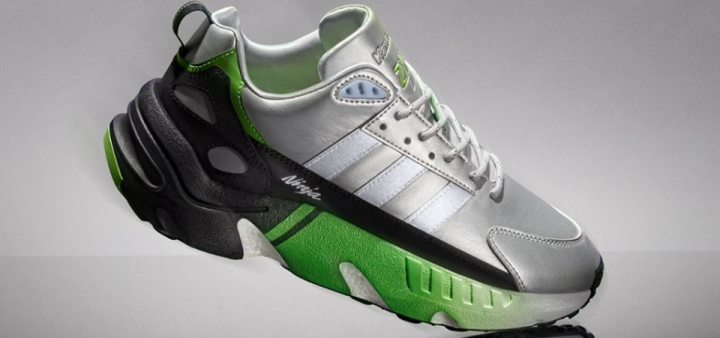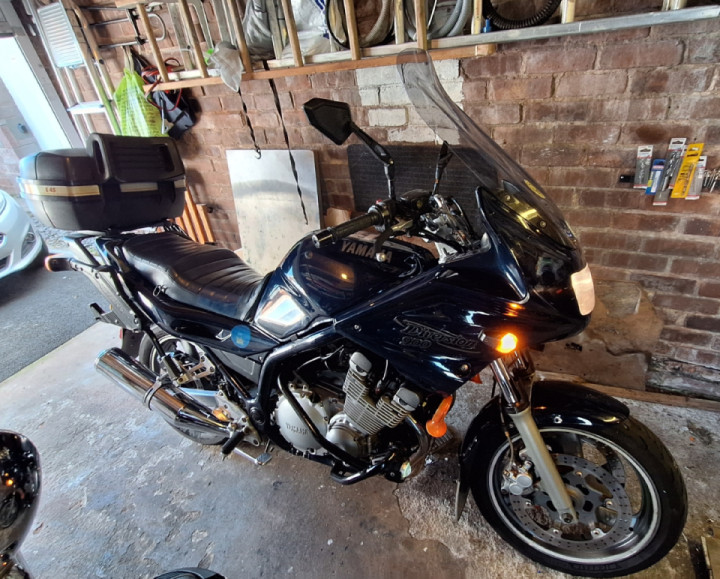
Kawasaki Z1300: Let’s get physical
Such was the impact of the Z1 Kawasaki on its release in 1972, it could have been generally accepted that this was as far as conventional motorcycle wisdom would go. But no; within twelve months, back in Japan, Kawasaki engineers were already hard at work on something that would make the Z1 look like a middleweight.

The project had the code name Model 203, described in-house as a “Touring Sports machine”, with the emphasis on reliability, ease of maintenance, and comfort. From the beginning, it was conceived as a shaft-drive model and various engine configurations – all greater than 1200 cc – were considered, including V4, square four, in-line four and in-line six. The six got the nod, as being easier and cheaper to build, plus having an in-built marketing king-hit. Water-cooling was also adopted, not just for more efficient cooling of the inner cylinders, but because it reduced the overall width and was quieter mechanically. There were several locations tried for the required radiator, including under the seat and between an early twin-headlamp design.
It soon became clear to the design team that the original semi-sporting concept was not viable, and by late 1976, the first metal prototype of a complete rethink emerged. The all-gear primary drive was found to be harsh and noisy, and this was replaced by a Hy-Vo chain, which necessitated a slightly wider crankshaft. Four separate dampers were also grafted into the final drive system to smooth out the power delivery. The six separate carburettors were replaced with three twin-choke units in an attempt to reduce the considerable width at the point of the rider’s knees, and the capacity increased to 1,286 cc. Finally, the styling was altered to reflect the squarish look that was being adopted across the range, notably on the Z1000 Mk2. And the Model 203 became the Z1300, or in the USA, the KZ1300.

At the time of its Australian release in February 1979, the Z1300, at 327 kg (720 pounds) with fuel, oil and water, was the heaviest motorcycle ever to come out of Japan. And despite the fact that the marketing department had re-pitched the model from ‘Touring – Sports’ to ‘Touring’, several of the first bikes to arrive were entered for the Unlimited Production Race at the Easter Bathurst meeting on April 14th and 15th. Notably in the saddle were two of racing’s hard men – Graeme Crosby and Garry Thomas – but few gave the big Z much of a chance against the new CB900 Honda and the established Suzuki GS1000, particularly in the hands of such guns as Tony Hatton and Alan Hales. From the start, Jim Budd and Roger Heyes made the best starts, but on the first run down Conrod Straight, Thomas came steaming past, with Hatton tucked into the considerable slipstream. To the roars of the huge spectator gathering, Thomas slid and bounced the big six around for lap after lap, with Hatton clinging grimly on behind. With one and a half laps to go Hatton got his nose in front over the mountain and pulled a sufficient break down the hill to hold the advantage to the flag, but Thomas’ runner-up spot was rightly hailed as a hero’s ride. It also instantly re-defined the Z1300’s capabilities in the minds of prospective purchasers, and even at $4,500 there were quite a few.

There was, of course, considerable muscle in the top end of the market already, with Yamaha’s surprisingly effective XS1100, Suzuki’s GS1000, and Honda’s own half-dozen cylinder model, the CBX 1000. But as far as sheer specification went, the Z1300 was right out in front. At the tip of the package is a big, rectangular quartz-halogen headlight, atop which sits an equally big, rectangular instrument panel which houses the usual speedo and tacho, as well as water temperature and fuel gauges. The 27-litre fuel tank delighted the touring types and careful sculpting meant that the capacity was achieved excessive width. The cooling department necessitated a fairly large radiator with a plastic-bladed cooling fan that was wired separate to the ignition switch, so that it activated itself at will, whenever the sensor detected temperature in the block.
Naturally, the main attraction is the six-cylinder engine itself, although this is not as gargantuan as might be imagined, and nowhere near as imposing as the Honda version. Perhaps the reason is the absence of finning on the block and head, the flat surfaces giving the appearance of a car-type motor. Inside, conventional wisdom abounds, with a DOHC valve arrangement, plain bearing crankshaft, with a jackshaft (like the CBX) between the crank and the gearbox. On the left end of the crankshaft sits a harmonic balancer and it certainly works – for a long stroke (62 x 71 mm) engine, the Z1300 is silky smooth. Similarly, the transmission contained no real surprises, with a five-speed gearbox, large wet multi-plate clutch and shaft final drive. Power output was around 120 horsepower and 130 for the later fuel-injected models.
An unusual (for the time) touch was the anti-theft switch, which is activated by inserting a key into the left side cover to isolate the ignition circuit.
Road testers of the time all expressed various degrees of amazement that the Z1300 was superb in the handling department – better than the CBX but not quite in the league of the GS1000. Kawasaki paid serious attention to making the frame as rigid as possible and getting the steering head angle just right for comfortable touring without sacrificing precise steering in the twisty bits. The front forks, with an unusual leading-axle arrangement, were the biggest of the day at 41 mm, and this has a lot to do with the excellent steering. Damping is by air/oil. The rear, on the other hand, was criticised for being under-damped, with performance dropping off when the units became hot.
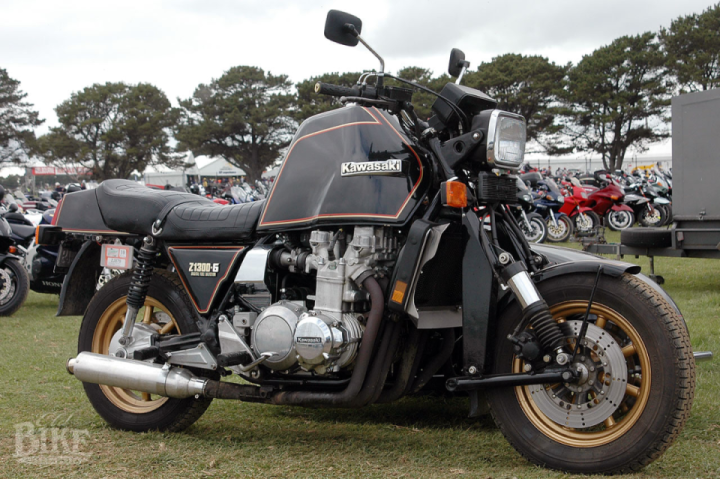
The original Z1300 was criticised for its heavy fuel consumption in an era when the buying public, particularly in USA, had suddenly become aware of the price of petroleum. The switch to electronic fuel injection went some way to alleviating the problem, while the chassis received air-suspended shock absorbers at the rear and air-assisted springing at the front. In 1983, production was switched from Japan to Kawasaki’s factory in the USA, and local-market models known as The Voyager, with windshield, a top case and slight revisions to the frame.

For a short time, the Victoria Police force used Z1300s, but their weight and lack of manoeuvrability made them unpopular and they were soon phased out. In Australia, the Z1300 holds the unofficial record for a round-Australia trip. Two policemen set off in 1981 for an attempt on the ‘record’ – one hit a Kangaroo, curtailing his journey, while the other rider, Ross Atkins made it home after 6 days, 22 hours and 51 minutes. The model seems to attract boffins and home engineers. British specials-creator Allen Millyard spliced two engines together to make a 2300 cc V12, and there are many examples of trikes, sidecars and even choppers.
The fan club
The Z1300 is the sort of motorcycle that polarises opinion. Quite often, it’s a case of love at first sight, at least it was with Ron Weste, a long-time BMW owner and accomplished touring motorcyclist.
“The year was 1979 and I had ridden to Bathurst on my BMW R90/6 for my annual pilgrimage with my mate on his Kawasaki Z1R 1000. Ben had the Kawasaki agency in Mildura at the time, “ Ron recalls. “ I can clearly remember parking the bikes and walking towards Conrod Straight when I noticed some sort of disturbance happening ahead in the crowd. As we approached I could see spectators dividing, making a clear path for a large motorcycle to negotiate its way to where the equally large rider parked and dismounted the machine, which looked like nothing I had ever seen before. I turned to Ben and said, ‘What the hell is that?’ and in his usual quiet and unassuming manner Ben simply said, ‘That, my friend, is the new Kawasaki Z1300 six cylinder’. My chance to actually ride a Z1300 came a year or so later when Ben offered me a ride on his “13” at Mildura. Immediately I hit the starter I hit the starter button I knew I was in for a thrilling ride, the smooth six cylinder engine purred quietly, not at all like the pulsations issued from a BMW boxer of the period. As I opened up the three twin-choke Mikuni carburettors the big bike came to life and all the pre-conceived heavy handling qualities melted away as we rocketed up to and over the legal limit in seconds. I knew from that moment on it was a love affair, and I was hooked.”
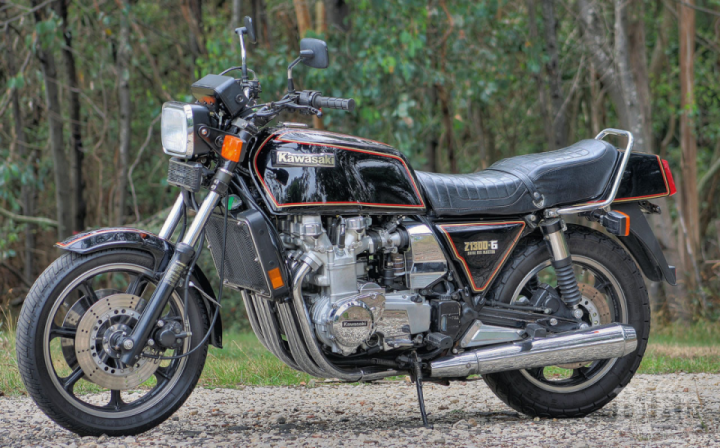
Ten years passed before Ron got the chance to own a Z1300, when his son Peter, who ran a motorcycle wrecking business, phoned to say he had a low-km 1981 model traded in. Without hesitation, Ron flew to Sydney, picked up his new purchase and motored happily back to Melbourne. Since then he has owned eight Z1300s and has become quite an authority on the marque, not just in Australia but internationally. “Some years ago I made contact with Wilco Vonk, president of the Z1300 Owners Club in Holland and we have been in regular contact ever since. In 2007 I received an invitation from Wilco to travel to Holland to attend the 30 years celebration of the announcement of the Z1300, the event to be held in September 2008 – the year of my 70th birthday. That trip to Holland was the highlight in my 54 years of motorcycle riding. I was offered a 1979 model Z1300 from a collection of six cylinder models – Benellis, Hondas and Kawasakis – owned by Johann, a friend of Wilco’s. The next ten days were full of interesting rides along the dykes, stopping in small rural villages and generally keeping away from the main roads whenever possible. The highlight was a rally attended by about 80 Z1300s from Holland, Germany, France and England. Some real characters turned up, particularly one French guy on a turbocharged 1300, one of only a handful made in France. When asked what sort f power output the bike gave he replied, ‘ At 3,000 revolutions I get 80 ‘orsepower, but a 5,000 I get 2 undred orsepower, the ‘ang on and flap like ze flag!’ I saw several of the special ‘Legendary’ model, bout 200 of which came out of the Kawasaki factory in 1988 at the end of the Z1300 production run – these bikes are now fetching good prices if and when they come onto the market. “

Ron Weste has also built up a thorough knowledge of the spares situation for the model. “The engines are complex and not without problems. Early models used excessive oil; it wasn’t uncommon to run out of oil and cook an engine. Kawasaki soon replaced the sump pan with a 6.9 litre job. They also had an expensive habit of slipping a link or two on the timing chain with disastrous results of bent valves, but these problems were fixed on later models. If you own a Z1300 and haven’t had a modification on the cam chain tensioner, do it immediately. Over the 20 years of Z1300 ownership I have cultivated some good parts suppliers. Years ago Kawasaki Australia used to have quite a large amount of spares, but these have virtually dried up. I have accumulated cables and various bits and pieces as insurance against possible future requirements. David Ewing (david@kz1300.com) in the USA has an extensive website and offers a worldwide service for supplies of parts and advice. Another site worthy of note is mcg@z1300.de in Germany – Helmut offers excellent service, mostly 10 days from order to delivery. If you are thinking about buying one of these now classic motorcycles, expect to pay from $3,000 – $5,000 for a rough example, and around $15,000 for a mint fuel-injected model, as only about 2,000 of these came out of the factory. Restoration costs can be astronomical if you can get the new parts. Used parts can be an alternative, but build a good engine with new parts first and save yourself a lot of money in the future. Good contacts in Victoria are Gert Roewer at Wallan (0416 035784) and John Kaiser at Mt. Duneed via Geelong (03 52641641).”
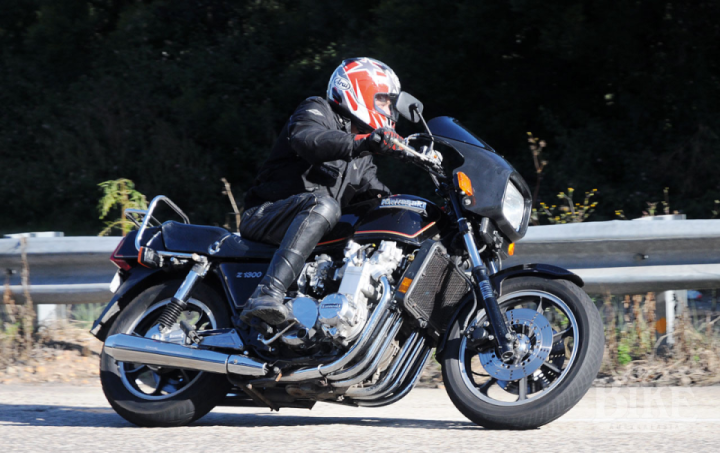
Andrew Greuter, from Bilpin in the Blue Mountains has owned his Z1300, a 1980 model, for 26 years. It was sold new by Brian Collins Motorcycles in Parramatta to his mate Don Tolson, who clocked up 17,000 kilometres in the next four years before selling the bike to Andrew. An after-market handlebar fairing has been fitted since new. This model, in the second year of production, featured the larger sump which was hastily catalogued after problems with excessive oil temperature and consumption. At the rear, air shocks replaced the coil spring versions of the 1979 model. Since he took over ownership, Andrew has added another 35,000 kilometres which has included a couple of trips to Queensland and a bit of touring in western NSW. Like other Z1300 owners, he sings the praises of the ‘13’s’ superb smoothness and says that although a bit on the heavy side at low speeds, it becomes a delight to ride once under way.
Star of the Show
Michael Samootin acquired his 1979 Z1300 in 2006 as a virtual basket case. The frame was hand painted and the engine green – there’s no accounting for some tastes! Inside it was no better, with oversized pistons, bent valves, and clapped timing chain. The speedo read 50,971 kms, but the cable was broken so the actual mileage was anyone’s guess. With help from his friend Wayne Waddington (whose Suzuki RE5 was featured in OBA 3), the tired old ‘13’ was put into a form where it could be ridden from Sydney to Michael’s home in Melbourne. At this point Michael decided upon a rebuild, in stages, with the engine dispatched to the model guru Gert Roewer, while Michael himself undertook a complete overhaul of the front end, from the handlebars to the brakes. The engine received a head rebuild, cylinder hone and an external make-over, and with the fettled front end, was now in what Michael describes as a ‘semi-decent condition that allowed me to ride it for a couple of years. In the 2008 Christmas holiday, Michael and his wife loaded up the Z1300 and did a tour of Tasmania, which is where he really developed a strong admiration for the model. “At slow speeds you have to be on your game, but once underway it feels like a 900,” he enthuses. “ The engine is super smooth and the torque is phenomenal. In Tasmania, the bike was fully laden with all the bags full, extra gear on top of that, plus rider and passenger – about half a ton’s worth – yet it would pull up any hill in top gear easily.” The only problem with the heavily laden bike in 1979 spec was the rear shocks, which tended to sag and make the front end uncomfortably light. For this reason, easily adjustable air shocks were soon standard, which could be inflated or deflated depending on load.

When Michael heard that the national Vintage Japanese Club rally was to be held in Melbourne in 2009, he decided on a total restoration. He had been accumulating genuine parts, either NOS Kawasaki or used parts, mainly from eBay, for some time. For some components, like the radiator, he had to buy three to make one good one, and it was a similar story for the exhaust system. This time it was a nut and bolt job, with Gert once again tackling the engine. A new standard size cylinder block was sourced from USA, black steel parts were powder coated, panel work sent out for painting, and chroming and zinc plating done in Melbourne. A nice addition was a set of Vetter luggage, also from the USA, while other bits like switches came from Germany, stickers and pin striping from UK, but the hardest component to source was the seat. After a six month world-wide search, one was found in Japan. To get the front brake operation up to scratch, Michael sent the master cylinder to a firm in Shepparton, where it was bored and re-sleeved.
Michael admits that his original training as a fitter and turner helped in the restoration. His more recent vocation, as an instructor with Stay Upright, plus racing experience in the 250 Production class in the late 1980s, was also beneficial in appreciating how to extract maximum satisfaction from actually riding the machine.
In March 2010, the Vintage Japanese Club again staged their national rally at Healesville Victoria, and Michael’s freshly restored Z1300 scooped the pool – Best Kawasaki, Best Restoration, Best Bike 1976-1980, and the big one, Bike of the Rally. It doesn’t get much better than that, but when you see this magnificently-finished machine in the flesh, it’s easy to see why the accolades went his way.
Specifications – 1979 Kawasaki Z1300
- Engine: Liquid-cooled DOHC six-cylinder, 2 vales per cylinder, cams driven by Hy-Vo chain, plain bearing crankshaft with wet sump lubrication.
- Displacement: 1286 cc (62 x 71 mm)
- Compression ratio: 9.9:1
- Carburation: 3 x 32 mm CV double choke Mikuni
- Ignition: Electronic
- Transmission: Hy-Vo chain primary drive through jackshaft. Shaft final drive
- Brakes: Front: 2 x 305 mm discs
- Rear: 1 x 295 mm disc
- Front suspension travel: 150 mm
- Rear suspension travel: 85 mm
- Fork rake: 28 degrees
- Fork trail: 100 mm
- Tyres: Front: 110/90V 18 Rear: 5.10V17
- Dry weight: 297 kg
- Seat height: 835 mm
- Wheelbase: 1580 mm
- Ground clearance: 160 mm
Story: Jim Scaysbrook • Photos: Jim Scaysbrook, Ron Weste, John Ford. Credit:oldbikemag
#Kawasaki #KZ #KZ1300 #Moto #Bike #Motorcycle














